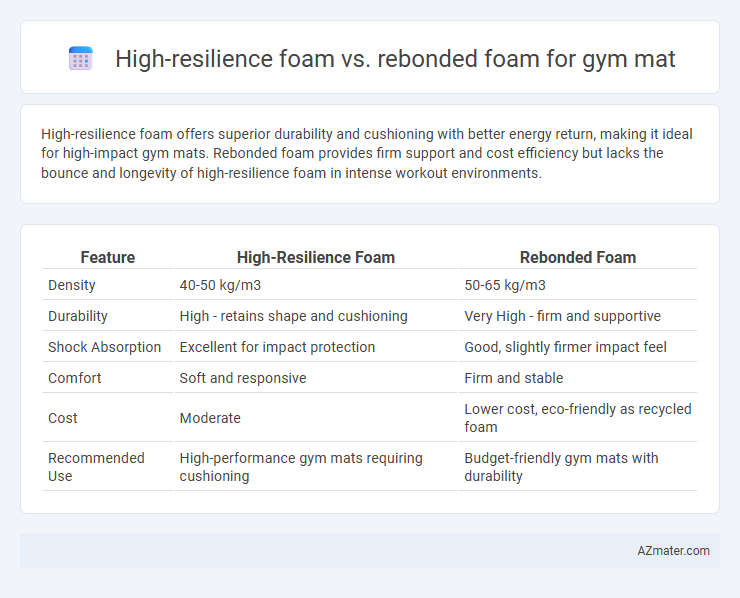High-resilience foam offers superior durability and cushioning with better energy return, making it ideal for high-impact gym mats. Rebonded foam provides firm support and cost efficiency but lacks the bounce and longevity of high-resilience foam in intense workout environments.
Table of Comparison
| Feature | High-Resilience Foam | Rebonded Foam |
|---|---|---|
| Density | 40-50 kg/m3 | 50-65 kg/m3 |
| Durability | High - retains shape and cushioning | Very High - firm and supportive |
| Shock Absorption | Excellent for impact protection | Good, slightly firmer impact feel |
| Comfort | Soft and responsive | Firm and stable |
| Cost | Moderate | Lower cost, eco-friendly as recycled foam |
| Recommended Use | High-performance gym mats requiring cushioning | Budget-friendly gym mats with durability |
Introduction to Gym Mat Materials
High-resilience foam offers superior elasticity and durability, providing excellent shock absorption and energy return for gym mats, making it ideal for high-impact activities. Rebonded foam, composed of shredded foam pieces bonded together, is denser and firmer, offering strong support and cost-effectiveness for heavy-duty use. Choosing between high-resilience and rebonded foam depends on the required balance of comfort, durability, and budget for gym mat applications.
What is High-Resilience Foam?
High-resilience foam is a type of polyurethane foam characterized by its high-density structure and superior elasticity, providing excellent support and durability for gym mats. It offers enhanced cushioning and rapid response to pressure, making it ideal for high-impact activities and prolonged use. Compared to rebonded foam, which is made from shredded foam pieces bonded together, high-resilience foam delivers a more consistent and resilient surface that maintains its shape and performance over time.
Understanding Rebonded Foam
Rebonded foam, commonly used in gym mats, is made from shredded pieces of high-resilience foam bonded together with adhesive, resulting in a dense, durable material that provides excellent shock absorption and support. It offers superior resilience and longevity compared to traditional foam, making it ideal for high-impact activities. Its formulated density ensures enhanced comfort and stability, essential for heavy-duty gym use where cushioning and durability are critical.
Durability: High-Resilience vs Rebonded Foam
High-resilience foam offers superior durability for gym mats due to its open-cell structure and elasticity, providing excellent resistance to wear and tear from heavy use. Rebonded foam, made from shredded foam scraps bonded together, is dense and durable but tends to compress over time, leading to reduced cushioning and resilience. Choosing high-resilience foam ensures longer-lasting support and shape retention, essential for high-impact gym activities.
Comfort and Support Comparison
High-resilience foam offers superior comfort and support due to its ability to quickly regain shape and provide consistent cushioning under pressure, making it ideal for gym mats used during intense workouts. Rebonded foam, composed of shredded foam pieces bonded together, provides firmer, denser support but may lack the same level of comfort and responsiveness as high-resilience foam. For gym mats, high-resilience foam enhances shock absorption and joint protection, while rebonded foam delivers durability and firmness suitable for heavy-duty support.
Shock Absorption Capabilities
High-resilience foam offers superior shock absorption for gym mats due to its open-cell structure that quickly disperses impact forces, reducing stress on joints during high-intensity workouts. Rebonded foam, made from recycled foam pieces bonded together, provides firm support but generally has less energy return and impact absorption compared to high-resilience foam. The enhanced durability and elasticity of high-resilience foam make it ideal for environments requiring sustained shock absorption and cushioning performance.
Maintenance and Longevity
High-resilience foam offers superior durability and maintains its shape under repeated stress, making it ideal for gym mats requiring long-term resilience and minimal maintenance. Rebonded foam, while cost-effective and dense, tends to compress and degrade faster, necessitating more frequent replacement or refurbishment. Choosing high-resilience foam enhances longevity and reduces overall maintenance costs in high-traffic gym environments.
Cost Efficiency and Value
High-resilience foam offers superior durability and consistent rebound, providing long-term cost efficiency for gym mats despite a higher initial price. Rebonded foam, made from recycled scrap, delivers a budget-friendly option with decent resilience but tends to compress faster, reducing its value over time. Choosing high-resilience foam optimizes performance and longevity, while rebonded foam suits short-term use with lower upfront investment.
Best Applications for Each Foam Type
High-resilience foam offers superior elasticity and durability, making it ideal for gym mats used in high-impact activities such as aerobics, gymnastics, and martial arts that demand rapid response and long-lasting support. Rebonded foam, composed of recycled foam scraps bonded together, provides firm density and excellent shock absorption suited for heavy-duty applications like weightlifting platforms and equipment padding where stability and protection are paramount. Selecting the appropriate foam depends on the specific gym activity, with high-resilience foam excelling in dynamic, fast-paced exercises and rebonded foam best for static, heavy-load environments.
Choosing the Right Foam for Your Gym Mat
High-resilience foam offers superior durability and responsive cushioning, making it ideal for gym mats that require consistent support and shock absorption during intense workouts. Rebonded foam, created from recycled foam scraps, provides firm support and excellent density, which is beneficial for heavy-duty use and weight-bearing exercises. Selecting the right foam depends on balancing resilience for dynamic activities and density for stability, ensuring safety and comfort tailored to your specific gym routines.

Infographic: High-resilience foam vs Rebonded foam for Gym mat
 azmater.com
azmater.com